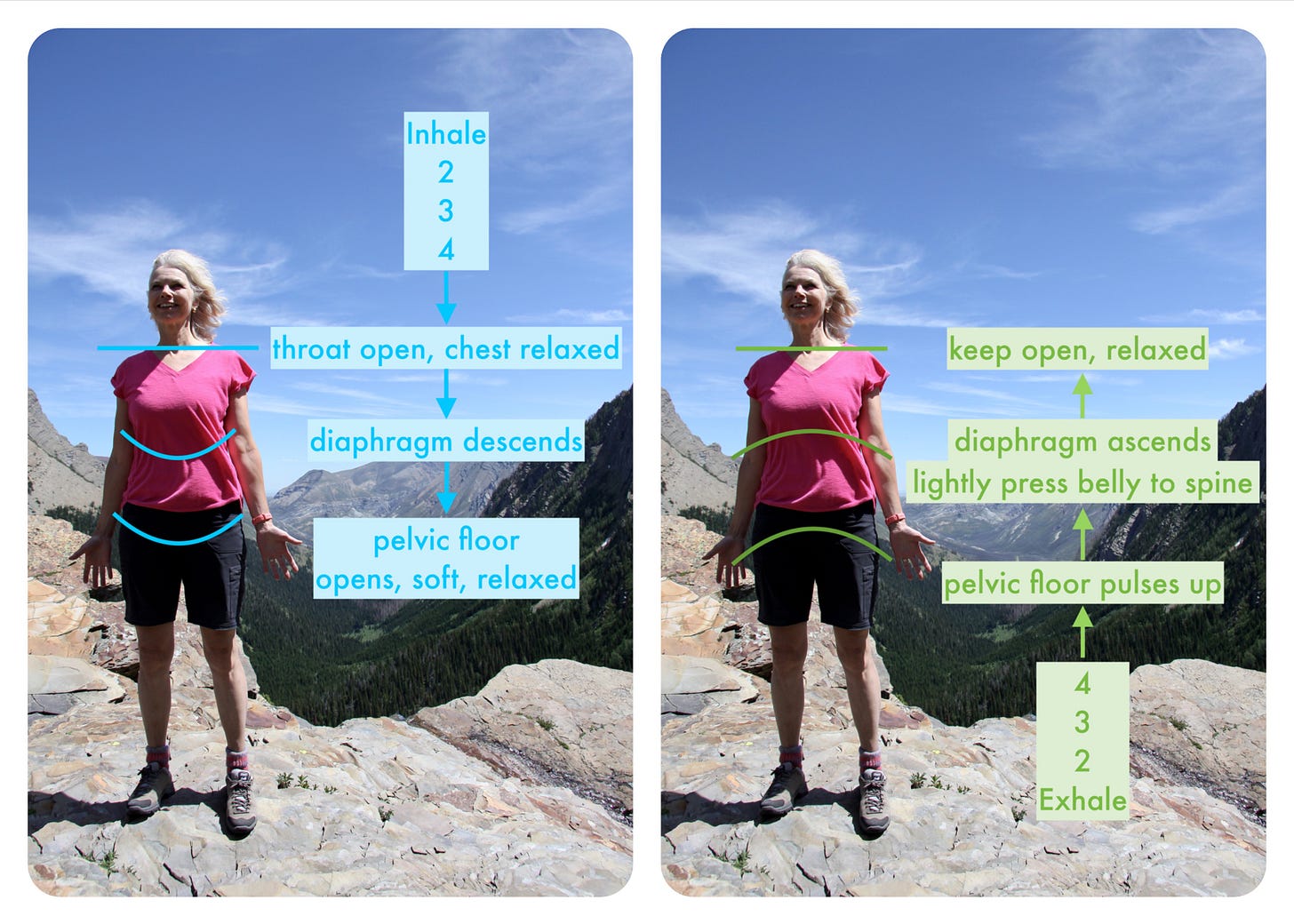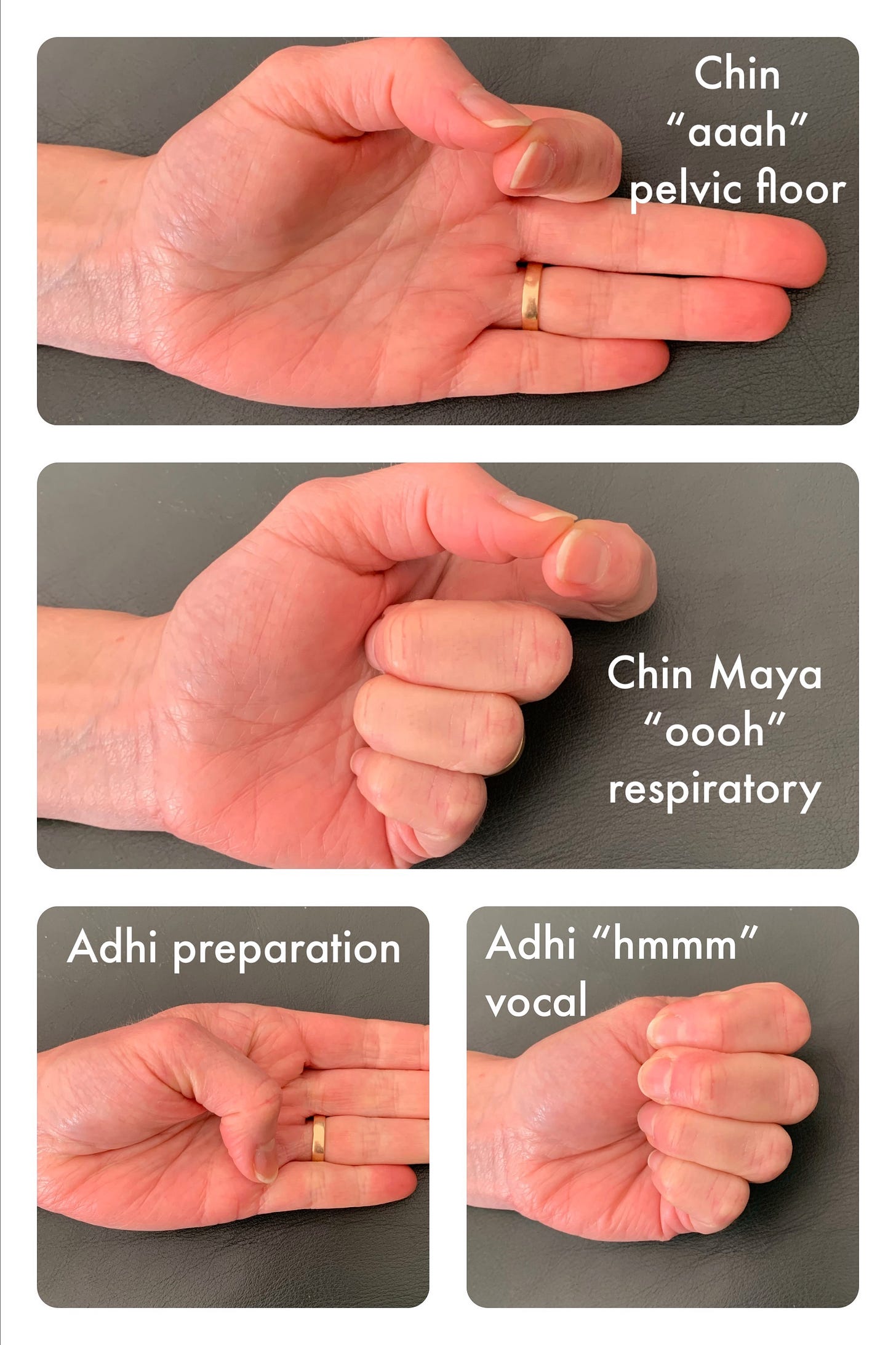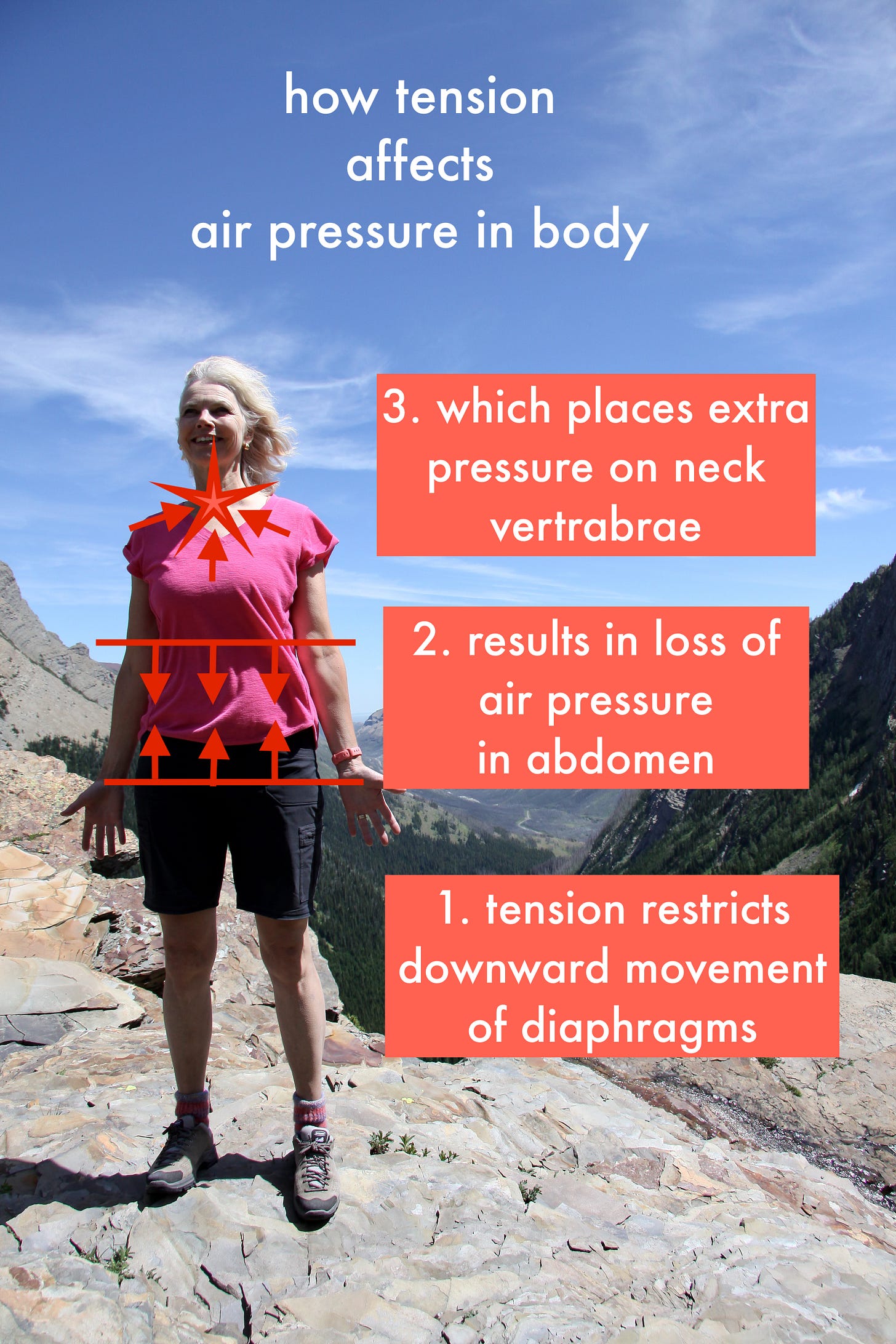Affairs of the Heart (2): Dance
The dance of the 'diaphragms' (there is more than one) makes the 'heart' sing.
Yes, the main respiratory diaphragm has two sister diaphragms. Combined they are the three major breathing diaphragms in the body:
vocal folds diaphragm
respiratory diaphragm (Affairs of the Heart (1): Diaphragm)
pelvic floor diaphragm
When all three diaphragms dance (breathe) together, the heart sings 🎶.
The Basic Practice
Slow Dancing Diaphragms in Belly Breathing
why?
to coordinate actions of diaphragms to improve breathing patterns and overall health
posture set-up
you choose: lying, sitting or standing
respect your limits, modify where needed
As much as possible keep the breathing slow, smooth, equal and rhythmic.
Adjust the length of breath based on your body. If a count of 4 is too much, try breathing in out to a count of 3. Experiment, have fun!
As you . . . Inhale, 2, 3, 4
1st diaphragm - vocal folds:
inhale softly through the nose, throat is open
keep upper chest, neck, and shoulders relaxed
2nd diaphragm - respiratory:
allow inhaling breath to be slow and smooth
feel how the slower inhale allows the respiratory diaphragm to more easily press (plunge-contract) downwards
belly rises
3rd diaphragm - pelvic floor:
invite breath to descend as far down as possible to the pelvic floor
allow the pelvic floor to become soft, open and gently pressing downwards in concert with the respiratory diaphragm
As you . . . Exhale, 2, 3, 4
3rd diaphragm - pelvic floor:
‘lightly’ give the pelvic floor a pulse upwards
2nd diaphragm - respiratory:
add a ‘slight’ abdomen belly to spine contraction as this diaphragm moves upwards and relaxes back under the rib cage
notice how again the pelvic floor and respiratory diaphragm move in concert
belly falls
1st diaphragm - vocal folds:
exhale can be through pursed ‘O’ shaped lips which allows for an easier, longer exhale and naturally lifts pelvic floor and contracts belly to spine
or exhale can be gently through the nose
still keep neck, upper chest and shoulders relaxed

Explore the Movement - the heart sings
add your singing voice (sounds) on the exhale
keep with pelvic floor gently lifting up and light engagement of belly to spine
each of the sounds is associated with one of the three diaphragms
notice how each sound comes from the associated area
“aaaah” comes from the lower abdomen and pelvic floor diaphragm
“ooooh” comes from the mid torso area and respiratory diaphragm
“hmm” comes from upper chest and vocal fold diaphragm
Yoga Practice - hand mudras
Mudra is the Sanskrit word meaning ‘closure’ or ‘seal’. It refers to the numerous hand gestures used during meditation and yoga practice. Each of the mudras has a different purpose or focus.1
Here are the hand mudras you can add with the sounds.2
Chin with “aaah” for pelvic floor
bring index finger to tip of thumb, remaining fingers are open and relaxed3
Chin Maya with “oooh” for respiratory
bring index finger to tip of thumb, remaining fingers curl inwards to the palm
Adhi with “hmmm” for upper chest/vocal
if possible bring tip of thumb to base of pinkie finger, remaining fingers wrap around thumb (essentially making a light fist)
Brahma with “ahoomm = aum” for uniting all three diaphragms
two fists together
Everyday Living
I encourage you to use an easeful, equal in and out belly breath with coordinating actions of pelvic floor as your everyday ‘go to’ breath.
Coordinated pelvic floor movement aids in improved respiratory diaphragm movement and dare I say it improved my continence control (overtime).4
adapt the breath
However, when lifting or using strong movements, you will need to brace your core. Rule: keep abdominal muscles engaged and pelvic floor contracted both on the in and out breath while lifting or moving.
Improve your sleep. Use easeful, soft, slower, rhythmic belly breathing and allow everything to relax, including the pelvic floor. On every 'exhale’ invite yourself to let go and relax even further.
Discover Amazing
A lack of coordinated breathing of all three diaphragms is linked to many of our common health issues. Dr. Matthew J. Taylor maps this out in his “The 3 Diaphragms Model” video.5
Breathing well is about the management of air pressure within the body. If diaphragms cannot properly descend on the inhale then there is a loss of air pressure in the abdomen which results in increased pressure being inappropriately placed onto the neck vertebrae (neck pain). The loss of air pressure in abdomen also means the loss of downward pressure on the pelvic floor which causes loss of flexibility in the hips.6
Dr. Taylor explains that tension, tightness and/or structural limitations in the body affect breathing patterns.7 Therefore breath practice starts with becoming aware — become a 'tension detective'. Notice what you notice with kind curiosity and then invite your body to release the tension as you practice breathing with all three diaphragms in concert. Think of it as untying a knot. Keep at it!
Our breathing diaphragms are amazing! Discover yourself the health benefits of coordinating your dancing diaphragms as a daily breathing practice and enjoy the concert of making your heart sing 🎶 with more calm and peace.
Namaste
(the Light in me honors the Light in you)
keep dancing your breath
keep singing your heart out “aah” “ooh” “hmm" aum
Thanks to Norm Ritter for taking the photo in Waterton Lakes National Park (Canon) and photos of hands (iPhone).
Discover amazing treasures in the Archive:
Thanks for reading Explore Movement & Discover Amazing YOU! If not already a subscriber, subscribe now for free to receive new posts and support my work.
Disclaimer: Be safe, know your limits and move wisely without causing harm to yourself. Information provided in this newsletter is for you to explore and discover how your body works. It is not to diagnose any medical condition. Please consult with a physician or physiotherapist if you have concerns.
Candace Moore, Namaslay, page 58
Candace further shares: “Many people believe that using mudras help complete the energy circuit inside of us rather than letting it ‘escape’ through the tips of the fingers.”
As well, Molini Chatlani, Yogaflows, Page 88, shares: “The yogic understanding is that the fingers contain thousands of nerve endings which transmit energy. When fingers are connected, they unite various nerve channels in the sympathetic and parasympathetic nervous systems. A circuit of energy is produced, re-directed from your hands to your brain and back again.”
Molini Chatlani, Yogaflows, page 90-91
Chin Mudra connected with autonomic nerves (motor and sensory) and lower brain.
Chin Maya Mudra connected with cerebral cortex (vagus nerve) and middle brain.
Adhi Mudra connects with cerebral cortex (conscious, mental) and upper brain.
Candace Moore, Namaslay, page 59
also on page 59: “The thumbs are said to represent the supreme soul and the index fingers the individual soul, so the intention of doing the two is to connect those energies.”
In addition, my understanding: The bending of the index finger can also represent one's individuality bowing down to the supreme soul (or God).
A blog I read many years back about incontinence via connecting pelvic floor to breath. And recently found this blog on pelvic floor and singing very informative as well.
Dr. Matthew J. Taylor, The 3 Diaphragms Model, YouTube video (go to minute 5:00) as he shares common health issues due to less than optimum coordination of the diaphragms.
Dr. Matthew J. Taylor, The 3 Diaphragms Model, YouTube video (around minute 9:25) shares how primary chest breathing leads to lack of movement in respiratory diaphragm which leads to loss of intra-abdominal pressure and displaces upward pressure into the cervical (neck) vertebrae. The loss of intra-abdominal pressure also leads to loss of hip flexibility.
Dr. Matthew J. Taylor, The 3 Diaphragms Model, YouTube video (around minute 7:30) as he shares how tensions and structural limitations in the body make it difficult at first to allow for fuller movement of the diaphragms. Becoming aware of these tensions is the first step as you begin experimenting with breathing practices. Overtime and practice these tensions will lessen and the movement of the diaphragms becomes easier.






